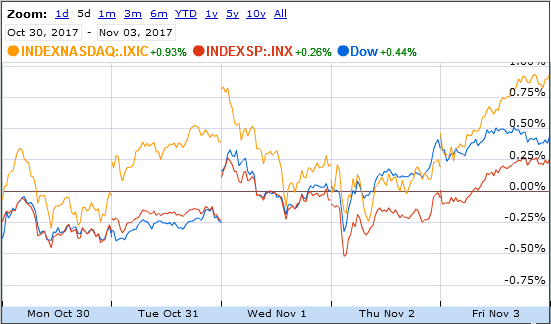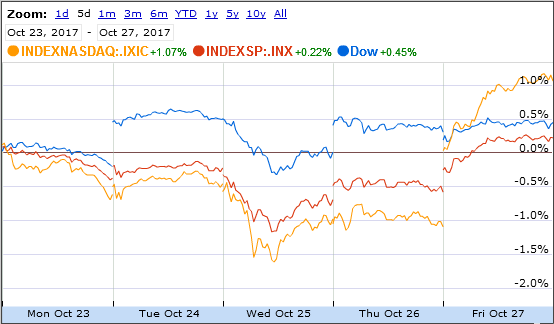Please note: there will be no market commentary next week. Have a great Christmas and New Year’s!
Stocks turned in their fifth straight week of gains with a modest rise this week. Through the Friday close, the Dow rose 0.4% and the S&P and Nasdaq both rose 0.3%. Bond prices moved sharply lower and yields higher. Commodity prices were up across the board, with gold rising 1.7%. Oil prices were higher by 1.9% to close at $58.35 per barrel. The international Brent oil moved up to $65.04.
Stocks turned in their fifth straight week of gains with a modest rise this week. Through the Friday close, the Dow rose 0.4% and the S&P and Nasdaq both rose 0.3%. Bond prices moved sharply lower and yields higher. Commodity prices were up across the board, with gold rising 1.7%. Oil prices were higher by 1.9% to close at $58.35 per barrel. The international Brent oil moved up to $65.04.
It was all about taxes this week.
By now you’ve probably heard about the tax bill passed by Congress this week which will go into effect in 2018. There will be deep rate cuts for businesses and lower rates on the personal side.
The effect on businesses will significant. Companies with higher tax rates will fare the best, of course, and the stock of companies with high rates have outperformed the broader market recently.
By now you’ve probably heard about the tax bill passed by Congress this week which will go into effect in 2018. There will be deep rate cuts for businesses and lower rates on the personal side.
The effect on businesses will significant. Companies with higher tax rates will fare the best, of course, and the stock of companies with high rates have outperformed the broader market recently.
It’s not just the high tax companies that will benefit, but all companies will see some sort of benefit from this bill. It might not be lower rates, but other things like immediate expensing, which allows a company to write off the cost of an asset immediately as opposed to over time. Or the ability to repatriate cash held overseas at a lower rate, rather than the 35% or more from before. Or a handful of other benefits.
The benefits to these corporations will spill over to the workers, as well. This week we heard many companies announce plans to boost hiring, increase wages, and give bonuses. Combined with lower tax rates on the individual side, this will be an extra bonus for workers.
While the bill will be great for the economy and corporate profits, what will it do to the stock market?
One would think it would be good for the market, but that isn’t always the case. Just look at the reaction in the market this week – the markets stalled on the passage of the bill. This is because the direction of the markets doesn’t always follow the direction of the economy.
The image below shows that while the market and GDP often trend in the same direction, there are periods where they move in opposite directions. This means we shouldn’t load up on stocks just because of the passage of the tax bill.
The benefits to these corporations will spill over to the workers, as well. This week we heard many companies announce plans to boost hiring, increase wages, and give bonuses. Combined with lower tax rates on the individual side, this will be an extra bonus for workers.
While the bill will be great for the economy and corporate profits, what will it do to the stock market?
One would think it would be good for the market, but that isn’t always the case. Just look at the reaction in the market this week – the markets stalled on the passage of the bill. This is because the direction of the markets doesn’t always follow the direction of the economy.
The image below shows that while the market and GDP often trend in the same direction, there are periods where they move in opposite directions. This means we shouldn’t load up on stocks just because of the passage of the tax bill.
Economic data released this week was very good. Housing reports show considerable strength in the sector. Durable goods rose, though slightly less than expected. Personal income and spending were both higher, too.
The revised GDP report for the third quarter was also released, showing a slight tick lower in GDP than previously thought. GDP for that period still stands at 3.2% growth, though, which remains a respectable number.
The revised GDP report for the third quarter was also released, showing a slight tick lower in GDP than previously thought. GDP for that period still stands at 3.2% growth, though, which remains a respectable number.
Overall, the economic picture looks to be doing quite well. We often mention the Citi Economic Surprise Index, which tracks how economic data is faring relative to expectations. The index rises when economic data is better than economist expectations and falls on the opposite.
As you can see in the chart below, the index has risen sharply and stands at multi-year highs, which means economic data has been well above expectations. This tends to correlate strongly with the stock market, making it a positive sign for stocks.
As you can see in the chart below, the index has risen sharply and stands at multi-year highs, which means economic data has been well above expectations. This tends to correlate strongly with the stock market, making it a positive sign for stocks.
Lastly, we’ll touch on bitcoin since we’ve mentioned over the last few weeks. It’s been the hot market the last few weeks and everyone has been jumping on board.
While we understand and appreciate the concept, the price seemed to have risen too high and too fast to be sustainable. One of the many signs of the over-exuberance is the reaction in the market to companies changing their names to include the words “bitcoin” or “blockchain” in the name.
One of the more fun examples of this came this week from the Long Island Iced Tea company. The tiny company put out a press release that they will be focusing on the blockchain technology and changing their name to “Long Blockchain Corp.”
While we understand and appreciate the concept, the price seemed to have risen too high and too fast to be sustainable. One of the many signs of the over-exuberance is the reaction in the market to companies changing their names to include the words “bitcoin” or “blockchain” in the name.
One of the more fun examples of this came this week from the Long Island Iced Tea company. The tiny company put out a press release that they will be focusing on the blockchain technology and changing their name to “Long Blockchain Corp.”
The stock rocketed higher on the news:
This is highly reminiscent of the late ‘90’s, where companies would include “.com” or other internet-sounding words in their name and see the stock immediately shoot higher. These types of events tend to happen at the peak of exuberance.
Some cracks did begin to show as the week closed. The digital currency was trading above 19,000 at one point, only to fall sharply on Friday and trade in the 12,000-range. These volatile moves can shake out a lot of investors.
Next Week
Next week will be a very quiet one with the Christmas holiday. We’ll get a few economic reports, including more info on housing and consumer confidence.
Next week is typically when we see the “Santa Claus rally,” where stocks rise into the end of the year. It may sound silly, but on average, the market rises 1.4% over the next six trading days.
Investment Strategy
Still no change here. Stock prices remain on the high side from a short-term perspective. We don’t see signs of a big drop coming and are still positive on the market overall and very positive on the economy. We think the tax bill creates a tailwind for stocks, but as mentioned above, that doesn’t always translate into a higher stock market.
Bond prices have fallen sharply and yields have risen over the past week. We’ll be looking to see if buyers step in here to buy the higher yields as they have done in the past, or if this was a shift in the bond market and prices will keep falling.
As for the rest of the portfolio, bonds to protect against inflation, or TIPs, remain a good long term hedge for inflation. Floating-rate bonds will do well if interest rates eventually do rise.
Some municipal bonds look attractive for the right client, too. We like buying individual, insured names for these bonds, avoiding muni index bonds if possible. We keep a longer term focus with these investments.
Gold is another good hedge for the portfolio. It is only a hedge at this point – rising on geopolitical issues as a flight to safety.
Finally, in international stocks, we prefer developed markets to emerging ones at this time.
This commentary is for informational purposes and is not investment advice, an indicator of future performance, a solicitation, an offer to buy or sell, or a recommendation for any security. It should not be used as a primary basis for making investment decisions. Consider your own financial circumstances and goals carefully before investing. Past performance cannot guarantee results.
Some cracks did begin to show as the week closed. The digital currency was trading above 19,000 at one point, only to fall sharply on Friday and trade in the 12,000-range. These volatile moves can shake out a lot of investors.
Next Week
Next week will be a very quiet one with the Christmas holiday. We’ll get a few economic reports, including more info on housing and consumer confidence.
Next week is typically when we see the “Santa Claus rally,” where stocks rise into the end of the year. It may sound silly, but on average, the market rises 1.4% over the next six trading days.
Investment Strategy
Still no change here. Stock prices remain on the high side from a short-term perspective. We don’t see signs of a big drop coming and are still positive on the market overall and very positive on the economy. We think the tax bill creates a tailwind for stocks, but as mentioned above, that doesn’t always translate into a higher stock market.
Bond prices have fallen sharply and yields have risen over the past week. We’ll be looking to see if buyers step in here to buy the higher yields as they have done in the past, or if this was a shift in the bond market and prices will keep falling.
As for the rest of the portfolio, bonds to protect against inflation, or TIPs, remain a good long term hedge for inflation. Floating-rate bonds will do well if interest rates eventually do rise.
Some municipal bonds look attractive for the right client, too. We like buying individual, insured names for these bonds, avoiding muni index bonds if possible. We keep a longer term focus with these investments.
Gold is another good hedge for the portfolio. It is only a hedge at this point – rising on geopolitical issues as a flight to safety.
Finally, in international stocks, we prefer developed markets to emerging ones at this time.
This commentary is for informational purposes and is not investment advice, an indicator of future performance, a solicitation, an offer to buy or sell, or a recommendation for any security. It should not be used as a primary basis for making investment decisions. Consider your own financial circumstances and goals carefully before investing. Past performance cannot guarantee results.



















































